Most farmers have seen rain gun irrigation systems working and there are even many of them working in this country.
The rain gun is just one of many different systems used to add water to crops growing on land and perhaps the most obvious type is the centre pivot system where a long boom rotates fixed at its centre point, quite like a radar screen.
These systems are commonly seen around the world and they basically produce circular patches of crop.
Anyone looking at Google Earth images can pick these up easily where they are being used.
But as most land is laid out in squares, the centre pivot system means that an amount of land will not be irrigated in the corners.
Various systems attempt to use ways to supply water to the crop growing in the corners.
The most common method I had seen previously uses a small rain gun system at the end of the pivot.
However, I saw a very different system during one of our visits to a farmer in Queensland during the Irish Tillage and Land Use Society (ITLUS) tour in January 2020.
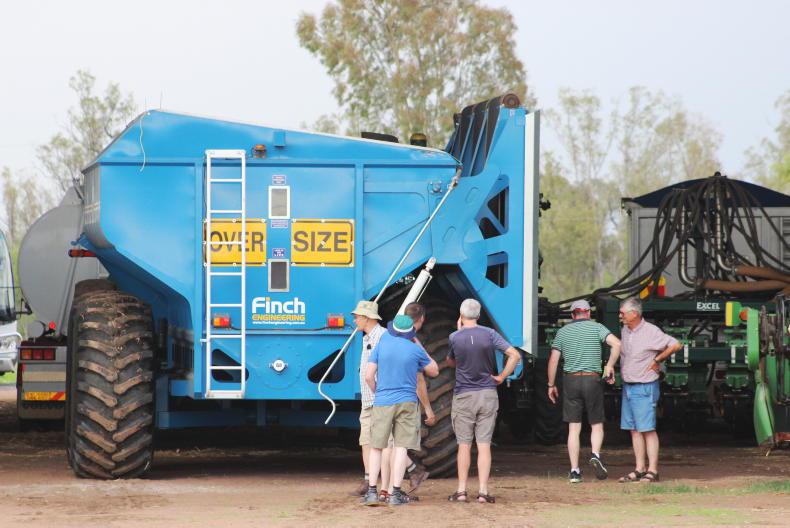
Some of the ITLUS crew inspecting a grain cart which was fitted with a belt elevator which worked on top to compensate for the extra width needed for controlled traffic farming.
The pivot carried a fine net and pipe system at the end of the boom.
As it rotated around, no water was emitted when it passed along by the edge of the circle, but, as it moved to the corners, water was poured out on to the net and it dripped to the ground beneath.
The corners had been laser-graded to control the fall and the surface or flood irrigation ran out from the circle along the ground to irrigate the crop that was growing there.
As the pivot moved to a corner, the control system knew to turn on the water at the end of the boom.

If you thought crows were a problem, try these guys for size. Emu's were a common pest of crops and they are nearly as big as ostriches.
This type of system is much kinder to the soil because the water is supplied as drips through the net rather than a hose effect that would come from a rain gun.
This system was used to extend the scope of the circle irrigation to enable crops to grow in the full square.
Bales per acre
Between four and 13 bales per acre might seem like the start of a conversation talking about straw in this country.
However, in this instance the reference was to cotton and the bales are bales of cotton fibre and the likely yields from non-irrigated and irrigated crops. Hence the need for irrigation systems.

A developing cotton boll.
The cotton producer in question was Ashley Keldar at Fairy Meadow, north of Dalby in the Darling Downs in Queensland.

Irrigated cotton plants.
This was the first time that most of us had ever seen cotton growing and it was a new experience.
At the time of our visit in January 2020, the value of cotton was AUS$500 (€314) per bale.
But it is an expensive crop to grow and it takes about 10 bales per acre to cover the costs of an irrigated crop.
Access to water
Irrigation is the difference between the low yields and the potentially high end - water drives yield. And if you have water, you can justify higher inputs to ensure higher yield potential.

Conditions were not always dry and dusty for doing field work like spraying.
As we drove into that farm, there were a lot of gas pumping stations dotted along the road and in the farm. It was interesting to learn that water comes with the gas.
We had seen this previously on one of the plains in Hungary, where a water source for wild cattle could be lit to have a flame rising and water falling from the same pipe.
Drying up
There was a real realisation that the gas in the area also provided the life to grow irrigated crops. But there was also the reality that when the gas dries up, so will the water.
Water for irrigation was relatively limited during the time when we visited. That meant that some of the cotton crops were irrigated while others were not.
Controlling the pivot speed and water application rate can be done remotely from a mobile phone.
The pivot can be slowed or speeded up in different parts of the paddock to add more or less water at different locations in the circle.
Pivot irrigation
While the farm used a number of pivot systems, it also has the option to do flood irrigation.
To do this, all the land had been laser-levelled to control the speed of surface water flow.
Because the paddocks are basically square, a pivot cannot irrigate the crop growing in the corners and the system used to do that was described earlier.
Interestingly, they were not growing cotton in the corners when we visited - indeed there was nothing sown.
This was because water was limited and they were trying to maximise the productivity of the crop growing in the circle.
That said, when water was less limiting, they might still not plant cotton in the corners, but rather other crops such as pigeon pea, durum wheat or even mung beans.
The crop sown in the corners tended to be sown on ridges to help enable flood irrigation of these areas.

Farm manager Liam explained the basic physiology of the cotton plant.
During our visit, farm manager Liam told us that they would commonly plant pigeon peas in the corners with cotton as an integrated pest control measure.
The peas were used to attract the normal pests that would attack cotton, so they were grown more to help save the cotton crop than to produce its own income.
The cotton crop
The cotton crop was planted in rows at about 10 seeds per metre length - the aim was to establish eight plants per metre.
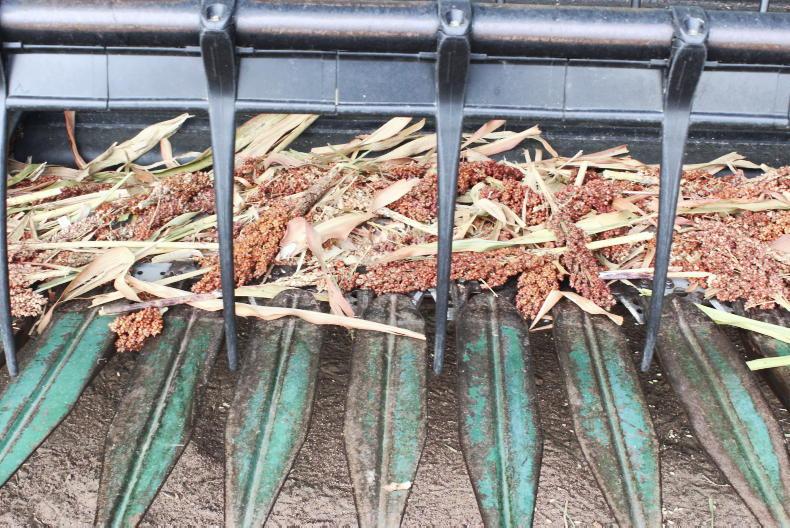
A specific header was used to harvest sorghum.
It is planted in rows and Liam was using narrower 30in row spacing to help keep the plant branches off the ground at harvest time.
The crop seemed to be nitrogen hungry and most or all of this was being applied as dissolved urea through the irrigation system.
The plant is somewhat like oilseed rape in the way it grows. It has a vertical main stem, taproots and potential for lateral branching.
Liam explained that the flowers are naturally white in colour, but once pollination is completed, the petals turn purple and fall off the plant.
Most farmers have seen rain gun irrigation systems working and there are even many of them working in this country.
The rain gun is just one of many different systems used to add water to crops growing on land and perhaps the most obvious type is the centre pivot system where a long boom rotates fixed at its centre point, quite like a radar screen.
These systems are commonly seen around the world and they basically produce circular patches of crop.
Anyone looking at Google Earth images can pick these up easily where they are being used.
But as most land is laid out in squares, the centre pivot system means that an amount of land will not be irrigated in the corners.
Various systems attempt to use ways to supply water to the crop growing in the corners.
The most common method I had seen previously uses a small rain gun system at the end of the pivot.
However, I saw a very different system during one of our visits to a farmer in Queensland during the Irish Tillage and Land Use Society (ITLUS) tour in January 2020.

Some of the ITLUS crew inspecting a grain cart which was fitted with a belt elevator which worked on top to compensate for the extra width needed for controlled traffic farming.
The pivot carried a fine net and pipe system at the end of the boom.
As it rotated around, no water was emitted when it passed along by the edge of the circle, but, as it moved to the corners, water was poured out on to the net and it dripped to the ground beneath.
The corners had been laser-graded to control the fall and the surface or flood irrigation ran out from the circle along the ground to irrigate the crop that was growing there.
As the pivot moved to a corner, the control system knew to turn on the water at the end of the boom.

If you thought crows were a problem, try these guys for size. Emu's were a common pest of crops and they are nearly as big as ostriches.
This type of system is much kinder to the soil because the water is supplied as drips through the net rather than a hose effect that would come from a rain gun.
This system was used to extend the scope of the circle irrigation to enable crops to grow in the full square.
Bales per acre
Between four and 13 bales per acre might seem like the start of a conversation talking about straw in this country.
However, in this instance the reference was to cotton and the bales are bales of cotton fibre and the likely yields from non-irrigated and irrigated crops. Hence the need for irrigation systems.

A developing cotton boll.
The cotton producer in question was Ashley Keldar at Fairy Meadow, north of Dalby in the Darling Downs in Queensland.

Irrigated cotton plants.
This was the first time that most of us had ever seen cotton growing and it was a new experience.
At the time of our visit in January 2020, the value of cotton was AUS$500 (€314) per bale.
But it is an expensive crop to grow and it takes about 10 bales per acre to cover the costs of an irrigated crop.
Access to water
Irrigation is the difference between the low yields and the potentially high end - water drives yield. And if you have water, you can justify higher inputs to ensure higher yield potential.

Conditions were not always dry and dusty for doing field work like spraying.
As we drove into that farm, there were a lot of gas pumping stations dotted along the road and in the farm. It was interesting to learn that water comes with the gas.
We had seen this previously on one of the plains in Hungary, where a water source for wild cattle could be lit to have a flame rising and water falling from the same pipe.
Drying up
There was a real realisation that the gas in the area also provided the life to grow irrigated crops. But there was also the reality that when the gas dries up, so will the water.
Water for irrigation was relatively limited during the time when we visited. That meant that some of the cotton crops were irrigated while others were not.
Controlling the pivot speed and water application rate can be done remotely from a mobile phone.
The pivot can be slowed or speeded up in different parts of the paddock to add more or less water at different locations in the circle.
Pivot irrigation
While the farm used a number of pivot systems, it also has the option to do flood irrigation.
To do this, all the land had been laser-levelled to control the speed of surface water flow.
Because the paddocks are basically square, a pivot cannot irrigate the crop growing in the corners and the system used to do that was described earlier.
Interestingly, they were not growing cotton in the corners when we visited - indeed there was nothing sown.
This was because water was limited and they were trying to maximise the productivity of the crop growing in the circle.
That said, when water was less limiting, they might still not plant cotton in the corners, but rather other crops such as pigeon pea, durum wheat or even mung beans.
The crop sown in the corners tended to be sown on ridges to help enable flood irrigation of these areas.

Farm manager Liam explained the basic physiology of the cotton plant.
During our visit, farm manager Liam told us that they would commonly plant pigeon peas in the corners with cotton as an integrated pest control measure.
The peas were used to attract the normal pests that would attack cotton, so they were grown more to help save the cotton crop than to produce its own income.
The cotton crop
The cotton crop was planted in rows at about 10 seeds per metre length - the aim was to establish eight plants per metre.

A specific header was used to harvest sorghum.
It is planted in rows and Liam was using narrower 30in row spacing to help keep the plant branches off the ground at harvest time.
The crop seemed to be nitrogen hungry and most or all of this was being applied as dissolved urea through the irrigation system.
The plant is somewhat like oilseed rape in the way it grows. It has a vertical main stem, taproots and potential for lateral branching.
Liam explained that the flowers are naturally white in colour, but once pollination is completed, the petals turn purple and fall off the plant.











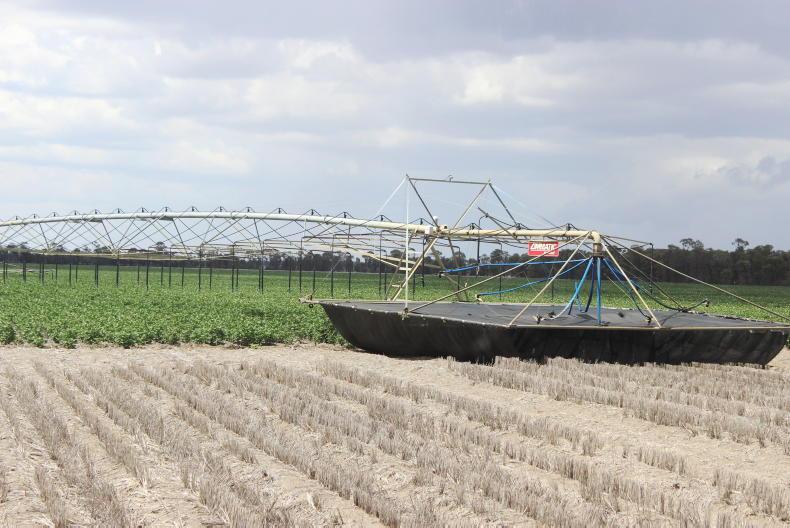
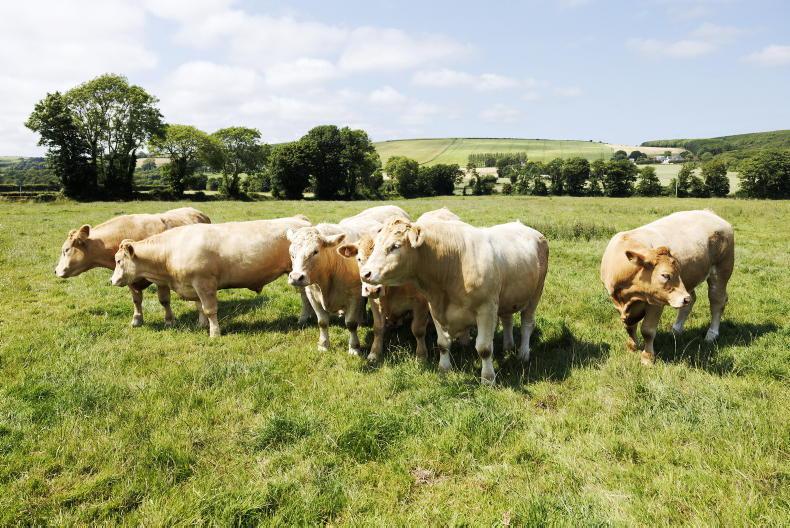

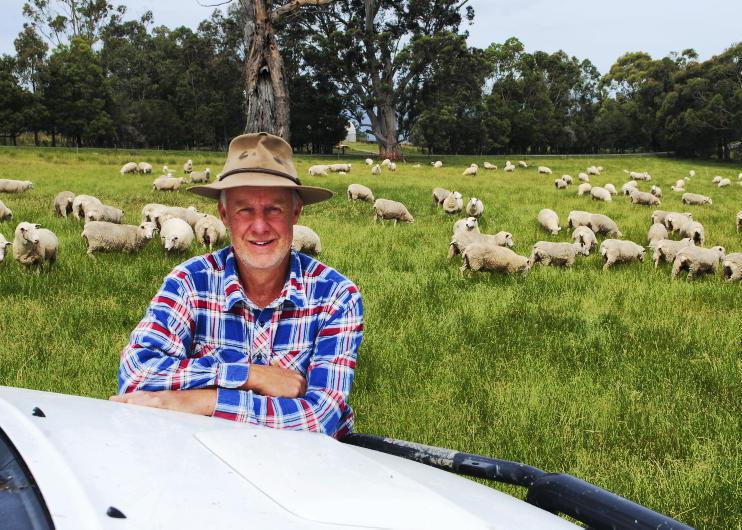
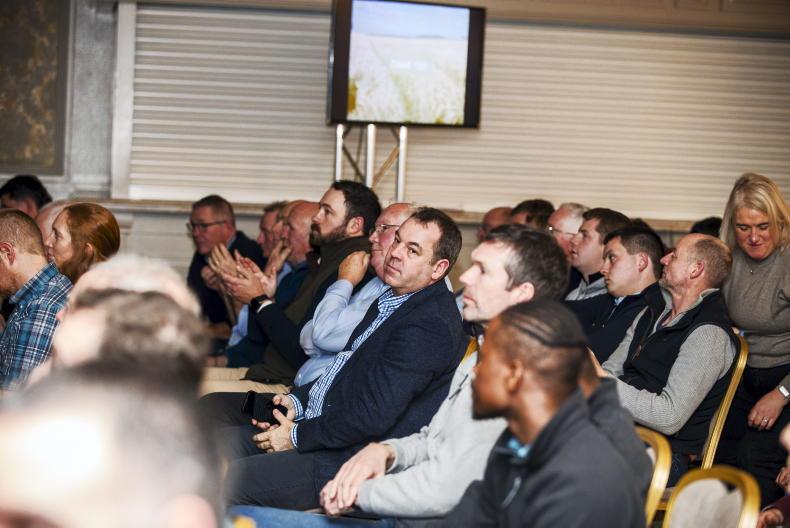
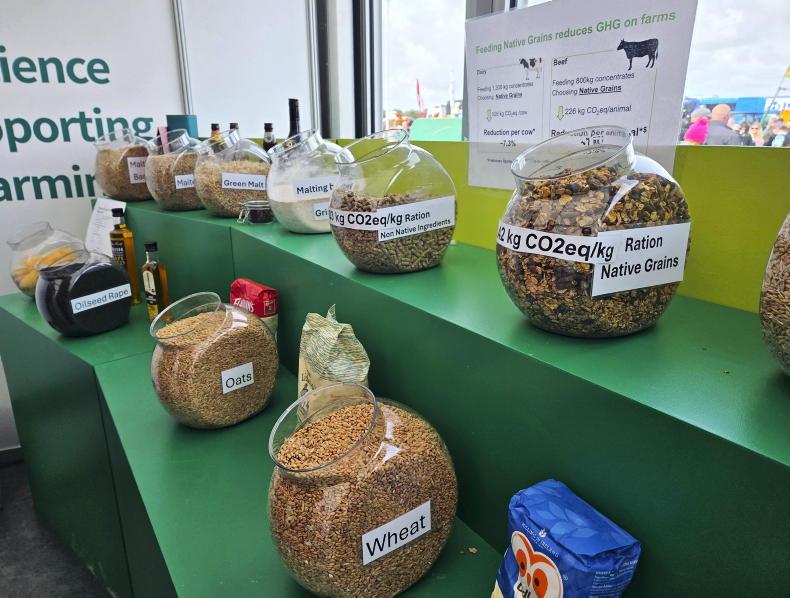
SHARING OPTIONS